As soon as I crossed the border, it was clear I was in a different country.
The roads were worse, the streets weren't paved, and everyone thought my riding
a bike to be a major attraction. In Mexico, I could pass through without
turning many heads, but in Guatemala, I was a traveling circus.
Up through about age 8, kids only seem to know one word - "gringo." They
shout as I pass, "Gringo, gringo," each time louder, as if they expect that if
they scream it loud enough, I will stop in my tracks and reply, "You're right,
I am a gringo. I hadn't noticed. Thanks for pointing it out. Have some
quetzales (Guatemalan money) for your trouble." Some kids have added the word
"pluma" (pen) to their vocabulary. They scream it, to remind me of the
horrible pen shortage facing developing nations such as theirs. When I pass
someone as I ride, I usually say good morning/afternoon, and I usually get a
reply and a smile. Ever once in a while I come across someone who wants to
show off their fluency in English by shouting, "Hey you! Hey you!"
My least favorite of the welcoming committee are the dogs. Dogs in Central
America come in two varieties - the ones who calmly stand by the side of the
road sniffing each others' behinds, and the chasers. The chasers, seeing that
I am encroaching on their territory, run full bore after me, biting at my
heels. If I am on a downhill I can outrun them, but on the hills I have to
unclip a foot and try to kick them before they bite me. I never was a big dog
fan, and this certainly didn't help. Sometimes the gringo shouting kids would
take off running after me, but they tire more easily and don't bite as
much.
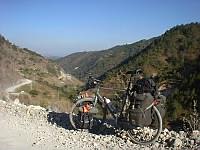 The terrain of Guatemala is amazing - sharp, jugle covered peaks as far as the
eye can see. Beautiful to look at, a pain in the butt to bike. It's one thing to bike uphill, but in Guatemala it's up, down, up, down, up, down. You can be climbing for most of the day and not gain any altitude at all. The dirt roads
don't help much either.
The terrain of Guatemala is amazing - sharp, jugle covered peaks as far as the
eye can see. Beautiful to look at, a pain in the butt to bike. It's one thing to bike uphill, but in Guatemala it's up, down, up, down, up, down. You can be climbing for most of the day and not gain any altitude at all. The dirt roads
don't help much either.
My first day in Guatemala, I found myself in the middle of nowhere, with it
getting dark, and no good places to sleep. I had heard rumors of a nearby town
with a hotel, but it forever seemed "mas adelante" (further.) Finally, well
after dark, I rolled into a town. I asked about a place to stay, but was
informed that the only place was on the top of the hill, in Colotenango. 15
minutes of steep climbing and I was there - Hospedaje Jalisco. A hospedaje is
basically someone's house where they rent out a room or two. At 10 quetzales
(~ USD$1.50) it was quite a bargain, even with no electricity (the whole town
was out.)feast
On my ride the next morning, a truck pulled out in front of me and the
driver got out. "Do you have a minute?" he asked. He had a letter he wanted
translated. I figured it was probably a note from some tourists he had met - I
am often asked to look at various things sent by travelers. Usually they also
have a coin from that country, and they want to know how much it is worth.
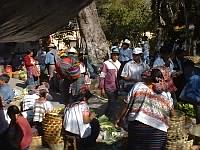 As I started translating, a touching story unfolded. Turns out that it was a
letter from an older couple in Kentucky, who were caring for the man's newborn
baby girl. She had a cleft lip, and went to the US for surgery. This was the
first news he had heard of her since she left a month ago. I had a hard time
holding back tears as the news of her health unfolded - a respiratory infection
and high fever, recovery, and preparation for surgery. I decided to take a
ride in his truck to Huehuetenango so that I could continue to talk to him. I
told him that I would serve as an intermediary - translate letters between
them. There was even email access in town, which makes the process infinitely
easier.
As I started translating, a touching story unfolded. Turns out that it was a
letter from an older couple in Kentucky, who were caring for the man's newborn
baby girl. She had a cleft lip, and went to the US for surgery. This was the
first news he had heard of her since she left a month ago. I had a hard time
holding back tears as the news of her health unfolded - a respiratory infection
and high fever, recovery, and preparation for surgery. I decided to take a
ride in his truck to Huehuetenango so that I could continue to talk to him. I
told him that I would serve as an intermediary - translate letters between
them. There was even email access in town, which makes the process infinitely
easier.
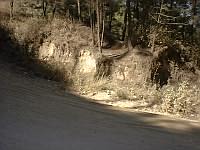 In the afternoon, I headed towards Sacapulas, but the terrain was challenging:
rutted dirt hills with rocks and very loose soil. I really needed my
suspension fork and knobby tires. My progress slowed, I stopped instead in
Aquacatan, a small and quaint town, with cobblestone streets and a great
morning market. This was the type of place that I would never have visited
were it not for the fact that I was bike touring. The ride to Sacapulas the
next day was worse than the previous. This was hard core mountain biking, and
I was on a fully loaded touring bike with hybrid tires. I would have to
unclip my inside foot and put my foot out for support going around corners to
keep the bike from sliding out from underneath me. In the course of an hour, I
had three pinch flats. A pinch flat is when the rim gets hit so hard that it
cuts two slits in the tube. They are difficult to patch, and I only had one
spare tube, having chucked the other in my mad weight savings frenzy. Each
time I would have to select the least damaged tube and try to patch it, the
repairs getting successively more tenuous.
In the afternoon, I headed towards Sacapulas, but the terrain was challenging:
rutted dirt hills with rocks and very loose soil. I really needed my
suspension fork and knobby tires. My progress slowed, I stopped instead in
Aquacatan, a small and quaint town, with cobblestone streets and a great
morning market. This was the type of place that I would never have visited
were it not for the fact that I was bike touring. The ride to Sacapulas the
next day was worse than the previous. This was hard core mountain biking, and
I was on a fully loaded touring bike with hybrid tires. I would have to
unclip my inside foot and put my foot out for support going around corners to
keep the bike from sliding out from underneath me. In the course of an hour, I
had three pinch flats. A pinch flat is when the rim gets hit so hard that it
cuts two slits in the tube. They are difficult to patch, and I only had one
spare tube, having chucked the other in my mad weight savings frenzy. Each
time I would have to select the least damaged tube and try to patch it, the
repairs getting successively more tenuous.
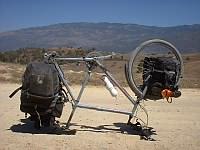 Everything on my bike got fully shake tested that day - I had to stop every
five minutes and adjust something; brakes, racks, wheels. The terrain was
gorgeous, however, and it made it all worth it. I rolled (or more like
bounced) into town just as my tires were flat, my repairs barely sufficient to
get me into town. The first order of business was to find a bike shop and buy
three new tubes. (A note to fellow bike tourers - it is essential to have rims
that will take shrader stems, since the funky stems on the tubes in Central
America fit in the same hole.)
Everything on my bike got fully shake tested that day - I had to stop every
five minutes and adjust something; brakes, racks, wheels. The terrain was
gorgeous, however, and it made it all worth it. I rolled (or more like
bounced) into town just as my tires were flat, my repairs barely sufficient to
get me into town. The first order of business was to find a bike shop and buy
three new tubes. (A note to fellow bike tourers - it is essential to have rims
that will take shrader stems, since the funky stems on the tubes in Central
America fit in the same hole.)
I had heard from both other travelers and locals that the nearby village of
Nebaj was well worth visiting. I decided to check it out for a day, but seeing
as it was at the end of a 30k uphill dirt road which wasn't on my route, I took
the bus. It was a wise decision.
The bus left from the central plaza in Sacapulas, but I couldn't quite
figure out when. I was told 5, 5:30, 6, and 6:30. I took advantage of all the
leisure time to rebuild my poor, abused bike. Wheel truing, drivetrain
cleaning, brake adjustment, pedal repair - all with an audience of about 10
kids. I'm not sure why the locals take such interest in my bike. It's really
not that different than their bikes. The way they look at it you would think
it was a spaceship. Of course, the fact that at 6'4" I tower over pretty much
everyone adds to the alien image. That point was made very clear earlier in
the day at lunch, when I almost got my head chopped off by a ceiling fan
installed at chin height. The school buses they use don't exactly have ample
leg room, either. The buses are old retired American school buses. They've
been repainted festively and had praises to Jesus plastered all over them, but
they're still pretty much the same. I still remember the blue vinyl seats from
my childhood.
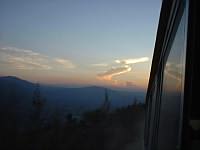 They certainly don't drive like any bus driver I had in school, however. These
guys make Muni (SF transit system) drivers look like little old ladies. The
bus barreled along the narrow dirt road, with only a couple of feet between
safety and tumbling down the mountain. On the ride to Nebaj, I had the honor
of riding in the best spot in the bus - standing on the bottom step, door wide
open, hanging onto the side. Occasionally the kid that collects money would
come down from the roof (with the bus still moving, of course) and pass by me.
If a passenger along the way wanted to get on, the bus would barely stop. The
routine was as follows: The bus slows, the kid hops off, the passenger gets on,
and the bus resumes normal speed. At some point the money kid grabs on to the
bus and climbs back to the front. The driver wouldn't slow down on turns, just
blow the air horn, figuring that if anyone was in our way, they would stop. At
one point, we came to a hairpin turn where a dead truck lay, its differential
oil running down the dusty road like blood. Somehow we managed to squeeze by.
It was definitely an E-ticket ride all the way.
They certainly don't drive like any bus driver I had in school, however. These
guys make Muni (SF transit system) drivers look like little old ladies. The
bus barreled along the narrow dirt road, with only a couple of feet between
safety and tumbling down the mountain. On the ride to Nebaj, I had the honor
of riding in the best spot in the bus - standing on the bottom step, door wide
open, hanging onto the side. Occasionally the kid that collects money would
come down from the roof (with the bus still moving, of course) and pass by me.
If a passenger along the way wanted to get on, the bus would barely stop. The
routine was as follows: The bus slows, the kid hops off, the passenger gets on,
and the bus resumes normal speed. At some point the money kid grabs on to the
bus and climbs back to the front. The driver wouldn't slow down on turns, just
blow the air horn, figuring that if anyone was in our way, they would stop. At
one point, we came to a hairpin turn where a dead truck lay, its differential
oil running down the dusty road like blood. Somehow we managed to squeeze by.
It was definitely an E-ticket ride all the way.
The sun was setting as we traveled, making for a great view. I, of course,
had to lean out and take a picture.
Nebaj was nothing like what I expected. After the hair raising bus trip up
the side of a mountain, I was expecting to find a remote village, where people
had uniquely evolved mountain sheep like climbing dexterity. Instead I found a
bustling town, with electricity, shops, even a radio station.
In my hostel, I met the first foreigner I'd seen in a long time - a Brit
named Philipa. When we met, we started by talking Spanish, and it wasn't
until 1/2 hour later, when our language ability started to strain as the
conversation got more complex, that she said, "We could speak Englilsh, you
know."
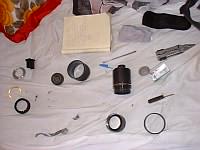 The next day was market, and I was determined to get up early and go shooting.
I was up at 7, ate breakfast, and cleaned my camera gear in preparation. On
one lens, a filter (a glass disk which screws onto the front) got cross
threaded, and after the repeated jolts and vibrations from my bike ride, had
become completely jammed. I used increasingly greater force trying to remove
it, eventually messing up the focus ring in the process. I had rendered the
lens useless. I immediately went into MacGiver mode and started to disassemble
it. I didn't have a jeweler's screwdriver set, so I used the concrete floor of
my hotel room to grind down the tip of my swiss army knife to form a tiny
screwdriver. I then completely disassembled the lens, laying all the tiny
screws and parts on my bed. Two hours later, I had a working lens. I still
hadn't managed to get the filter off, though, and I wasn't about to give
up.
The next day was market, and I was determined to get up early and go shooting.
I was up at 7, ate breakfast, and cleaned my camera gear in preparation. On
one lens, a filter (a glass disk which screws onto the front) got cross
threaded, and after the repeated jolts and vibrations from my bike ride, had
become completely jammed. I used increasingly greater force trying to remove
it, eventually messing up the focus ring in the process. I had rendered the
lens useless. I immediately went into MacGiver mode and started to disassemble
it. I didn't have a jeweler's screwdriver set, so I used the concrete floor of
my hotel room to grind down the tip of my swiss army knife to form a tiny
screwdriver. I then completely disassembled the lens, laying all the tiny
screws and parts on my bed. Two hours later, I had a working lens. I still
hadn't managed to get the filter off, though, and I wasn't about to give
up.
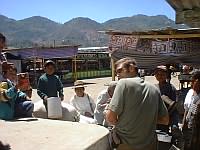 Later that day, I ran into Philipa again. We were both taking refuge from the
crowded, narrow passages and pushy women from the market. We were seated on
the steps of the cathedral, surrounded by shoe shine boys. Shoe shining is a
popular profession for young kids in Guatemala, and they are worse than car
salesmen when it comes to drumming up business. They will follow you around
for 15 minutes trying to convince you to get a shoeshine. The best repellant
is to wear Tevas, although that doesn't always stop the most determined ones.
I had forgotten my Tevas that day, and so we found ourselves joined by about 10
boys.
Later that day, I ran into Philipa again. We were both taking refuge from the
crowded, narrow passages and pushy women from the market. We were seated on
the steps of the cathedral, surrounded by shoe shine boys. Shoe shining is a
popular profession for young kids in Guatemala, and they are worse than car
salesmen when it comes to drumming up business. They will follow you around
for 15 minutes trying to convince you to get a shoeshine. The best repellant
is to wear Tevas, although that doesn't always stop the most determined ones.
I had forgotten my Tevas that day, and so we found ourselves joined by about 10
boys.
I was still determined to remove the filter from my lens. I had looked in
the market for something resemblig one of those rubber rings that you use to
get lids off of jars, but I had no luck. Philly suggested that I use the top
of one of the shoeshine boys' rubber boots. It seemed crazy enough to try.
The hard part was trying to convince one of them to lend me a boot. I was
offering 50 centavos for a one minute rental of a boot, but I didn't get any
takers. These kids, who would ruthlessly compete for the chance to shine
someone's shoes for 50 centavos, weren't biting. Perhaps they were afraid that
we might run off with one of their shoes. I finally found a willing kid, and
proceeded to try and unwedge my lens. It didn't work. All I managed to do was
get a lapful of dirt, which had spilled out of a hole in the boot. I gave
up.
I left Nebaj the next morning. I wanted to get a full day of biking in, so
I got up at 3:30 in order to catch the 4:00 bus. I expected to be the only one
on it, but when I got there, the bus was full. Everyone was sitting quietly in
their seats, waiting for the driver, who was slumped over the steering wheel,
to wake up. The only seat I could find was in the very back. Now Guatemalan
buses are like roller coasters; the most thrilling ride is in the front or the
back. Unfortunately, I had a stomach ache, and I really wasn't looking forward
to bouncing around for two hours. I literally had to hold on to my seat to
keep my head from hitting the roof on every bump. Each time I came down, my
already sore butt would slam into the thinly padded seat, and all the contents
of my stomach would get violently shaken. At the front of the bus was a sign
which read, "Yo manejo, Dios me guia" (I drive, God guides me) and on the back
of the bus, painted in large letters, the word "Esperanza" (hope.) Hope, that
is, that God didn't guide us a few feet off course and send us careening down
the mountain. Hope, too, that the bowline knot that I used to tie my bicycle
to the roof would hold. (Let's see: the rabbit runs up the tree and down the
hole, no wait...)
The fastest way to remove the air bubbles from a soda is to keep shaking
it. Apparently, the same is true for the human digestive system, because by
the time we pulled into Sacapulas two hours later, my stomach was actually
feeling better. By 6:30 I was pedalling my way towards Chichicastenango, not
to be confused with the Chi Chi Rodriguez of golfing fame.
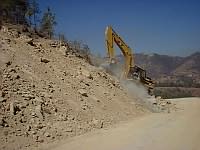 The ride was gruesome, with 70k of climbing, 10k of which was through a
construction zone. They had apparently decided to turn the one lane road into
a highway, and were busy completely regrading the road. I had to dodge falling
boulders that tumbled down from the hillside as they carved out a new path. By
the time I rolled into Chichi, I could barely walk up the hill from my hotel.
All I could think of was food and sleep.
The ride was gruesome, with 70k of climbing, 10k of which was through a
construction zone. They had apparently decided to turn the one lane road into
a highway, and were busy completely regrading the road. I had to dodge falling
boulders that tumbled down from the hillside as they carved out a new path. By
the time I rolled into Chichi, I could barely walk up the hill from my hotel.
All I could think of was food and sleep.



